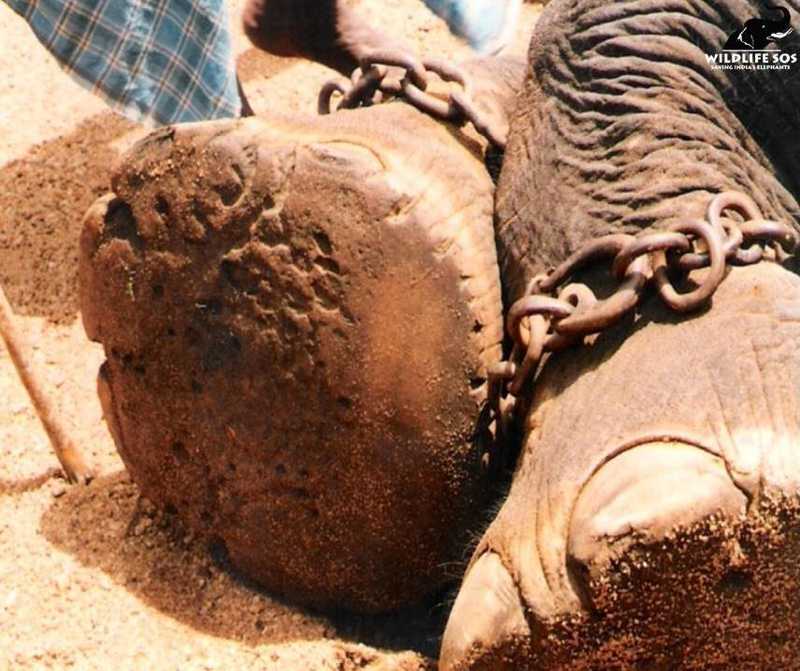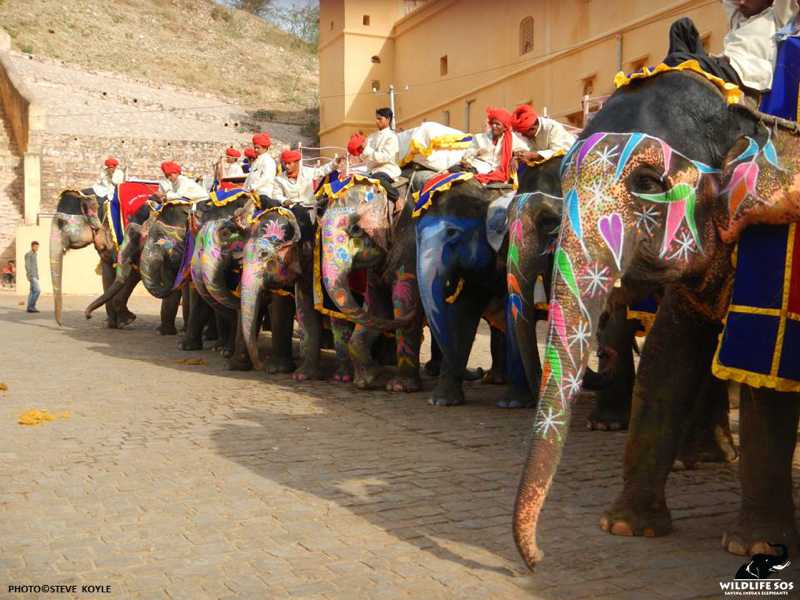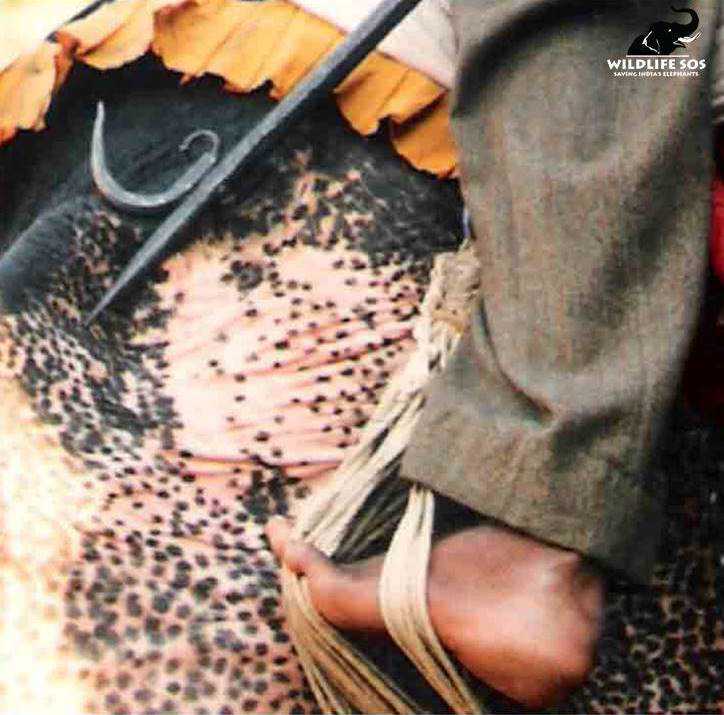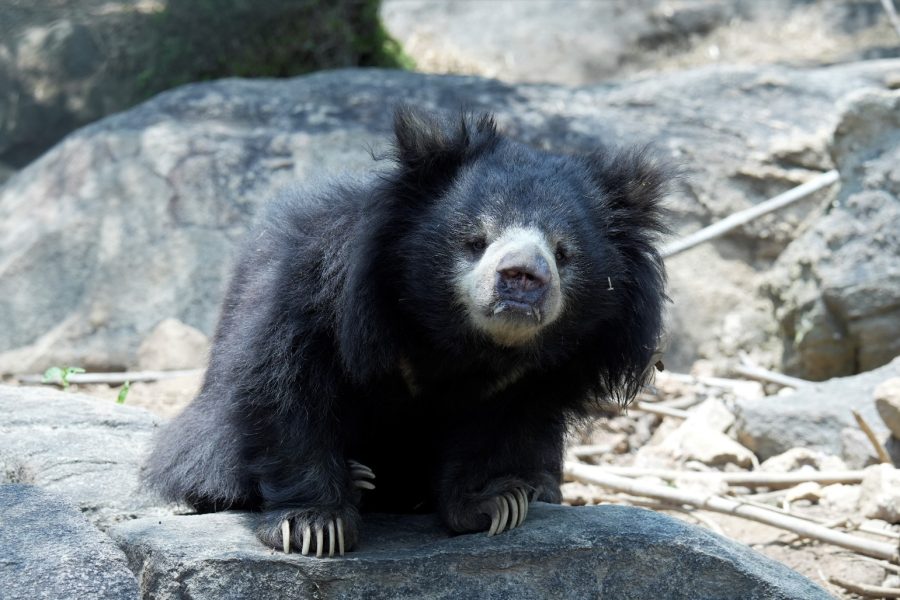My friends rode an elephant and said it was an amazing experience – what’s so terrible about it?
It may be your dream to ride an elephant, but it is an elephant’s worst nightmare to be ridden. Here’s what goes into making an elephant “rideable”:
- First, an elephant calf is captured from the wild, tearing it away from its mother and herd – as well as from any chance it has of a free, wild life. This is illegal and can be termed as “poaching.”
- The calf is restrained in a small squeeze contraption called a kraal and starved and beaten for months. This brutal “breaking-in process” called katti azhikal or phajaan, is intended to destroy the calf’s natural, wilful spirit and to instil so much fear in the young calf that it will allow humans to ride it for fear of suffering the same pain again.
- The elephant then spends the rest of its life living in constant fear- beaten frequently and regularly to reinforce the “training”. Furthermore, the elephant then is kept in isolation for all its life with no or little interaction with other elephants. This is psychologically detrimental for the elephant, causing it to become withdrawn and unhappy, and in turn engaging in stereotypic behaviour.
- Once in captivity, these elephants are often neglected and poorly cared for. They receive little or no veterinary care; their nutrition is compromised and they have restricted access to water. These captive elephants are housed on concrete floors, where they are chained for extended periods of time, often standing in their own dung and urine. This leads to foot rot and many diseases.
- The very act of riding is cruel – an elephant’s back was not designed to carry weight and yet the weight of the carrier, the mahout/keeper and the tourists on its back can put an intense amount of pressure on the animal’s spine. These weights can often exceed 200-400 kilograms of the ‘howdah’ and in addition to it the weight of the mahout and three adult passengers easily exceeds 600 kilograms—causing sores bruises, cuts and deformities in the animal’s back, but most importantly it leads to early arthritis and severe joint pains.
- Illegality persists in the elephant riding industry despite strict laws, with owners unashamedly flouting rules and lacking requisite ownership paperwork – taking advantage of the difficulty of enforcement to break all welfare and conservation laws.
Where do these elephants come from?
Most elephants in captivity have been poached from the wild, stolen away from their families as babies and then sold into cruel captivity. While there are some that are bred in captivity, this is extremely difficult and rare, as the neglect and abuse elephants face in captivity makes it difficult and often dangerous for them to conceive and give birth. Even if bred in captivity, elephant calves are separated from their mothers much too early and have to undergo the same brutal breaking-in process suffering extreme trauma.
How are these elephants trained?
The indoctrination process of a captive elephant is extremely brutal. The animal is caged, or tightly restrained for weeks while people beat it and force it to obey commands – a process known as ‘phajaan’ or the breaking of the spirit. The objective is to destroy any wild spirit within the elephant, to drive fear into it to the extent that it is too terrified to ever retaliate. In order to make it possible for anyone to ride the elephant, it has to be broken.

Why is it wrong to take away an elephant from its mother?
The strong maternal bond between an elephant calf and its mother is well-documented. An elephant mother fiercely looks after its calf and teaches it the necessary social and life skills needed for survival. In the wild, the calf learns to engage in complex social behaviour and problem solving, that enriches it psychologically. However, in captivity a calf is deprived of this critical bond and a chance to learn these important life skills.
Elephants are mighty endangered species. India, with nearly 60% of the world’s few remaining wild Asian elephants, remains the last stronghold of this incredible species in the wild. Their numbers in the wild look bleak at merely 22,000-27,000. At this rate of loss, India could lose the entire wild elephant population in the next 5 to 10 years if steps are not taken to conserve and protect them. To lose the few remaining wild elephants to simply abuse them to fuel the tourism industry is not only extremely irresponsible, but it could also spell doom for the entire species.
WHEN YOU RIDE AN ELEPHANT, YOU ENCOURAGE AND CREATE DEMAND FOR ILLEGAL TRAFFICKING OF ELEPHANTS FROM THE WILD!
How are these elephants trained to give rides to tourists?
The indoctrination process of a captive elephant is extremely cruel. The animal is tightly restrained for months while people beat it and force it to obey commands – a process known as phajaan or breaking of the spirit. The objective of this process is to simply destroy the wilful, independent spirit of the elephant to instil fear such that the elephant is too terrified to ever retaliate.
Does an elephant enjoy giving rides?
Besides the physical and mental abuse that an elephant faces to become rideable, the very act of riding is also physically torturous to the elephant. It may seem innocuous considering the large size of an elephant, but the protruding spine of the elephant is often forced to bear the entire weight of the ‘howdah’, the mahout and the tourists, resulting in excessive pressure on the spine, which leads to deformities, wounds and permanent disabilities. These elephants often develop burns, sores and wounds from the ropes that tie the carrier on, and the weight can result in them losing balance and breaking their legs – a broken leg is generally untreatable in an elephant causing permanent disability, early arthritis and painful joints or even death. The surface and inclination on which the elephant is made to walk can also lead to the wearing off of their sensitive footpads, especially if the path is rocky, tarred and prone to overheating, and if it is a hilly or an uneven terrain.
Is it legal to use elephants for rides? Are there any laws or guidelines in place to protect elephants used for rides?
- There are several guidelines and laws to help ensure the welfare of elephants, but these are ignored and violated by greedy owners and handlers:
- In order to use an elephant for rides, the owner must have an Ownership Certificate issued by the Forest Department, with all the details of the elephants’ name, sex, place of origin, microchip etc. and can only have been issued during the stipulated periods after the enactment of the Wildlife Protection Act, 1972 or the guidelines issued by Project Elephant. Different states in India have different rules for using elephants for rides – for example, elephants giving rides in Kerala are required to hold a performing animal permit from the Animal Welfare Board of India, while in Rajasthan, the use of the bull-hook and the use of bull elephants for rides is prohibited.
- Project Elephant has stipulated guidelines on the working and housing conditions necessary for the maintenance and upkeep of an elephant in captivity, including those that give rides, but these are never enforced nor is there mechanism in place for regular inspection unless a formal complaint is lodged.
Unfortunately, it is still legal to use an elephant for rides, if the owner has proper documents in place and adheres to the stipulated guidelines.
How do I know that the place I am visiting treats its elephants well?
Any facility that offers rides to tourists is abusing the elephants to keep them controllable while it is being ridden or painted over by humans.
Instead look for shelters that house rescued animals, that do not offer rides to tourists, and in fact work towards sensitizing public about issues related to wildlife conservation and welfare or Sanctuaries and National Parks where you can see wild elephants.
That said, however, beware as many private and abusive elephant tourist spots will claim to be sanctuaries/rescue centres and claim their elephants are rescued, when they are actually bought and continue to be exploited for tourist entertainment and commercial activities such as parades, temple ceremonies and other functions.

Is it safe to ride an elephant?
No, it is not safe for tourists to ride an elephant. Elephants are wild animals, and despite years of breaking in, sudden triggers like fear or stress can cause them to retaliate against their abusers. This results in a dangerous rampage in which multiple people are killed or injured and substantial damage is done to property. Very often, in a bid to escape their torturous lives, these elephants run amuck – putting at risk the lives of tourists and bystanders nearby, as well as the persons riding them. In 2005, two Belgian tourists in Jaipur were injured and their tour guide killed by an elephant when they were trying to take a picture with it. In 2011, a South Korean couple was critically injured after the elephant they were riding at Amer Fort started to run amuck, throwing the two from her back.
In addition, elephants in captivity lead stressful lives and are exposed to and carry contagious diseases like tuberculosis, which their weakened immunities are unable to tackle – and this can easily pass this on to other elephants or any human that interacts with them.
How do I know the elephant I ride is being abused?
We can take it for granted that all elephants being used for tourist rides are and have been brutally abused. There is no other way to make a wild animal conducive to being ridden. The elephant when used commercially is like a piece of equipment that earns money hand over fist.
You can look for tell-tale signs of physical and mental stress including cracked toenails, overgrown, cracked footpads, visible wounds and scars, blindness (opacity of the corneas), old age or dehydration (sunken temples), malnourishment (prominently visible spines and hollows in the head), and stereotypy (repetitive, monotonous motion like head bobbing, swaying or weaving that indicate extreme mental stress and trauma). You can also check if the elephant is chained, has rope burns and wounds from restraints; or if the keeper is using weapons like spears or a nail embedded in a harmless looking piece of wood to inflict pain on the animal, or shouts loudly in order to make their elephant obey commands.

Is it ever okay to ride an elephant?
No! Elephants do not belong in captivity – they belong in the wild and are wild animals. In order for tourists to be able to sit on their backs and ride them, they have to be poached from the wild, separated from their families and then beaten and abused in order to make them “ride-able for tourists. The heavy metal and wood contraption which is perched on their backs for your comfort called ‘howdah’ weighs a lot and combined with the weight of the tourists, becomes very heavy and damages their spine irreversibly.
What about the mahout or keeper riding the elephant bare back – doesn’t that hurt the elephant?
It is sometimes unavoidable for a mahout or a keeper to ride an elephant ‘bare back’ and without a ‘howdah‘ in captivity as in many cases this is the only safe way for a mahout to take an elephant out on a long walk for the purpose of exercising the elephant, particularly in places with people, villages, cattle, feral dogs etc around. It is important to note that this is done simply for the welfare of the elephant – exercise and the enrichment of a walk is critical for the elephant’s well-being, and in some cases sitting on top of the elephant neck is the only way to give it this exercise and make it walk. However, in such cases a distinction must be drawn between riding an elephant for commercial profit or entertainment and riding it for the safety of bystanders and the exercise of the elephant. Only a trained mahout may ride the elephant while exercising it and he does so without the paraphernalia of a ‘howdah’ and never allows anyone else to ride the elephant. He also ensures that he is sitting in a way that causes the least discomfort to the elephant and does not hurt the elephant in any way.
If it is cruel, why is still allowed to happen?
That’s where you come in! The ever-increasing demand from tourists for elephant rides is keeping this grotesque industry alive. If tourists stop riding elephants, this abuse and exploitation will also end! As long as there are huge profits to be made by exploiting these animals, the abuse and exploitation of the animals in the tourism and entertainment industry will continue.
SAY NO TO ELEPHANT RIDES, BE A RESPONSIBLE TOURIST!
What can I do?
- Stay informed- don’t visit places that offer elephant rides. Don’t support this evil industry. Inform your travel agent & your local guides about your preference.
- Share your opinion- be vocal and object strongly. Warn your friends, colleagues and contacts about why it is important to avoid riding elephants. Spreading awareness is the key to reducing exploitation and abuse of animals.
- Write to travel magazines, guidebooks, tour operators and travel agents to discourage them from offering elephant rides to tourists.
- Write to the local tourism department and the parks you visit expressing your disdain for elephant riding and request them politely that they take steps to put an end to it.
- Encourage and support only responsible tourism projects, which do not offer elephant rides and are reputed conservation centres, sanctuaries, national parks and wildlife reserves- where tourists and animal lovers are educated about these special creatures in a conducive space that is safe for everyone involved.




